CIRCLE TIME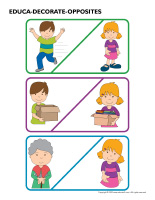
A treasure hunt to discover the theme
(Open educa-decorate-Opposites) Print and laminate. Set the illustrations on items throughout the daycare. Invite children to search for them. Name the items and invite children to guess the theme.
Educa-chat-Opposites
(Open educa-chat-Opposites) (Open giant word flashcards-Opposites) Print the questions and several word flashcards. Laminate them. Set the questions in a box so that children can take turns picking a card. Spread the word flashcards out on a table. Also print and laminate the “It’s my turn” card. Glue it on a Popsicle stick. It will help children respect the child who’s turn it is to speak. If you prefer, use a puppet or a stuffed animal linked to your theme. The questions will help children develop their observation skills, their vocabulary, their thinking skills, etc. Use this tool to animate discussion periods.
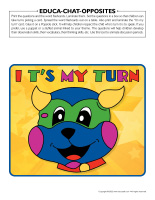
Point to (or name) the pictures
(Open word flashcards-Opposites) (Open giant word flashcards-Opposites) Print, laminate, and display the word flashcards on a wall next to your circle time area or on a piece of cardboard that can easily be moved around. Name a word and encourage children to take turns pointing to the correct word flashcard.
AREA SETUP
Thematic poster-Opposites
(Open thematic poster-Opposites) Print, laminate, and display where children and parents are sure to see it.
Educa-decorate-Opposites
(Open educa-decorate-Opposites) Print, laminate, and cut out the illustrations. Use them to decorate your walls and set the mood for the theme.
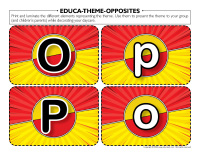
Stickers-Opposites
(Open stickers-Opposites) Print the illustrations on adhesive paper and use them to create a collection of unique stickers. Use them to reward children throughout the theme.
Educa-theme-Opposites
(Open educa-theme-Opposites) Print and laminate the different elements representing the theme. Use them to present the theme to your group (and children’s parents) while decorating your daycare.
PICTURE GAME
The pictures may be used as a memory game or to spark a conversation with the group. Use them to decorate the daycare or a specific thematic corner. (Open picture game-Opposites) Print, laminate, and store in a “Ziploc” bag or in your thematic bins.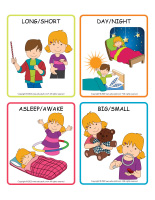
Images-Spatial orientation
Exceptionally this week, you will find a giant picture game that explores spatial orientation. It illustrates opposites very well. Use the images to decorate your daycare and create a thematic area. (Open picture game-Opposites)
ACTIVITY AND WRITING ACTIVITIES
Activity sheets-Opposites
(Open activity sheets-Opposites) Print and follow instructions.
Writing activities-O like opposite
(Open writing activities-O like opposite) Print for each child or laminate for use with a dry-erase marker.
Educa-nuudles-Opposites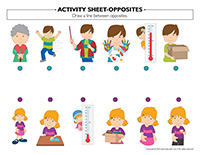
(Open educa-nuudles-Opposites) Print for each child. Have children color the sheet. Once they are done, they may use Magic Nuudles to turn the coloring pages into three-dimensional works of art.
Variation: If you do not have Magic Nuudles, ask children to fill the spaces designed for Magic Nuudles with bingo markers or stickers. To order Magic Nuudles
Stationery
(Open stationery-Opposites) Print. Use the stationery to communicate with parents, in your writing corner, or to identify your thematic bins.
LANGUAGE ACTIVITIES
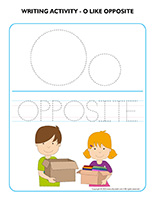
Word flashcards
Use the cards to spark a conversation with your group or in your reading and writing area. They may also be used to identify your thematic bins. (Open word flashcards-Opposites) (Open giant word flashcards-Opposites)
old/young, dirty/clean, pull/push, closed/open, wet/dry, asleep/awake, fast/slow, long/short, hot/cold, empty/full, day/night, big/small
Posters-Opposites
(Open posters-Opposites) Print and laminate the posters. Glue the posters that are opposites back-to-back. Hang them from the ceiling using invisible wire.
Posters-Spatial orientation
(Open posters-Spatial orientation) Print and laminate the posters. Glue the posters that are opposites back-to-back. Hang them from the ceiling using invisible wire.
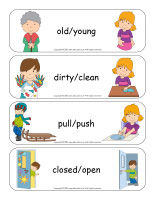
Story and memory game-Opposites
(Open story and memory game-Opposites) Print, laminate, and cut out the cards. Place them face down on the floor. Children take turns picking three cards and using the illustrated items to invent a story. If you prefer, print twice and use the cards for a memory game.
Scene-Opposites
(Open scene-Opposites) Print, laminate, and cut out. Children use the pieces to decorate the scene.
Tiny opposite cars
Set a bin filled with toy cars and other vehicles on your daycare floor. Invite each child to pick a car that they believe goes very fast, a race car for example. Encourage them to explain their choice. Next, ask them to find a slow vehicle, such as a train. Challenge children to find a big car and a small car. Invite them to pick a car and push it forward, then pull it backwards, per your instructions. They can also move it in a straight line and then in zigzags. They can roll it to the top of a slope and roll it down. Throughout the activity, explore and name a wide range of opposites.
SPECIAL DAYS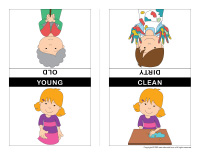
Opposites day
For an entire day, integrate as many opposites as possible. Invite children to wear their pyjamas to daycare. Put your clothing items on backwards and greet children by wishing them “good night”. Have children sit back-to-back during circle time. Walk backwards. Have children brush their teeth before eating. Serve dessert before the main course at lunch time. At story time, read the book from the last page to the first page.
The reversed mirror
Divide your group into pairs. One child from each team performs an action or says a word and his partner must perform or say the opposite. For example, if a child raises his right arm, the other child could raise his left arm. If a child says “hot”, his partner must say “cold”.
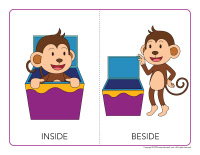
On the hunt for opposites
Show children a small object and invite them to find an “opposite object”, a large object. Next, show them a heavy object and have them search for a light object. Other examples of opposite items are soft/rough, hard/soft…
I can do the opposite
Select a child who will be the leader of the game and have him perform an action. The others watch him and perform the opposite action: run/walk, raise your hand/lower your hand, turn to the left/turn to the right.
Walking backwards
Instead of walking normally when you head to the bathroom, the lunch table, or the cloakroom, walk backwards. If you normally have children line up like a train, have your train back up instead of move forward.
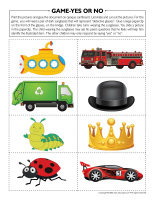
Yes or no
(Open game-yes or no) Print the pictures and glue the document on opaque cardboard. Laminate and cut out the pictures. For this game, you will need a pair of dark sunglasses that will represent “detective glasses”. Glue a large paperclip on the front of the glasses, on the bridge. Children take turns wearing the sunglasses. You slide a picture in the paperclip. The child wearing the sunglasses may ask his peers questions that he feels will help him identify the illustrated item. The other children may only respond by saying “yes” or “no”.
Bring a toy to daycare
If you normally do not allow children to bring toys from home to daycare, pick a day where you will do the opposite and authorize children to bring one of their toys to daycare to share with their peers.
Cleanup opposite
When it’s time to pick up the toys children have played with, spread them all over the place in an exaggerated fashion instead, just for fun.
You are hot, you are cold
Show children an object that you are going to hide. Ask them to close their eyes while you hide it. When you give the signal, children search for the object. Tell them they are “hot” when they are close to the hidden object and tell them they are “cold” when they are far from it. When a child sees the object, he sits down. The game continues until all the children have found the object. Those who are sitting down can help you direct their peers by telling them if they are “hot” or “cold”.
Backwards Day
(Open perpetual calendar-Backwards Day) Print.
Greeting: Invite everyone to wear their clothes backwards or inside out.
Circle time: Have children sit with their back to you to help children understand the importance of doing things the correct way.
Lunch and snacks: Serve dessert before lunch or serve breakfast for lunch.
Special activity: Do everything backwards all day long.
Read books from the end to the beginning, have children brush their teeth before lunch, etc. Walk backwards, spread toys around instead of picking them up, forego naptime (or change children’s naptime spots for the occasion).
Black and white day
(Open perpetual calendar-Black and white Day) Print.
Greeting: Invite everyone to wear black and white clothes. Wear a black or a white wig to greet children.
Circle time: Paint children’s faces with black and white makeup pencils. For example, paint their face to make them look like pandas.
Lunch and snacks: Set salt and pepper shakers on the table and encourage children to guess which one is which. Invite children to search for black and white items in their plate.
Special activity: Search for black and white items throughout your daycare. Have fun mixing black and white poster paint. Use white chalk to draw on black paper.
ROUTINES AND TRANSITIONS
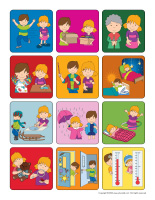
Game-This is my spot-Opposites
(Open game-This is my spot-Opposites) Print two copies. Laminate and cut out the cards. Glue one copy of each card on the table using adhesive paper. Drop the other copies in a bag. Children take turns picking a card to determine their spot at the table for the day. You may also use the cards to determine naptime spots or for your task train.
My opposites path
(Open my opposites path) Print, laminate, and press the illustrations on the floor to create paths leading to various frequently visited areas within your daycare such as the bathroom, the cloakroom, etc. If you prefer, simply use the illustrations to delimit workshops.
The opposite of good naptime habits
Integrate the theme at naptime in a variety of ways. For example, you can set up children’s naptime mattresses so that their head is where their feet normally are. Instead of having them sleep under a blanket, have them sleep on top of it. Instead of turning the lights off, leave them on. Use these opposites to help children realize how there is a good reason behind each good habit you normally try to apply to naptime. Ask them if they found it more difficult to fall asleep.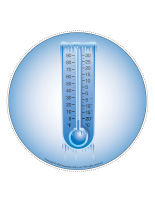
Cleanup opposite
When it’s time to pick up the toys children have played with, spread them all over the place in an exaggerated fashion instead, just for fun.
Walking backwards
Instead of walking normally when you head to the bathroom, the lunch table, or the cloakroom, walk backwards. If you normally have children line up like a train, have your train back up instead of move forward.
PHYSICAL ACTIVITY AND MOTOR SKILLS
Mobile opposites
Explore opposites as you encourage children to be active. Invite them to run fast like a cheetah and then run slow like a turtle. Have them walk heavily like a giant and then very lightly, like a mouse. They can walk forward, then backwards. Ask them to climb to the top of a play structure or hill and then make their way down to the bottom. When you go for a walk with your group, search for opposites: a big house and a small house, a big truck and a small car, a tall tree and a short tree, a light that is on and another one that is off, etc.
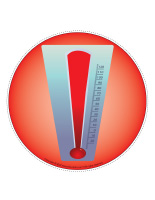
The reversed mirror
Divide your group into pairs. One child from each team performs an action or says a word and his partner must perform or say the opposite. For example, if a child raises his right arm, the other child could raise his left arm. If a child says “hot”, his partner must say “cold”.
On the hunt for opposites
Show children a small object and invite them to find an “opposite object”, a large object. Next, show them a heavy object and have them search for a light object. Other examples of opposite items are soft/rough, hard/soft…
You are hot, you are cold
Show children an object that you are going to hide. Ask them to close their eyes while you hide it. When you give the signal, children search for the object. Tell them they are “hot” when they are close to the hidden object and tell them they are “cold” when they are far from it. When a child sees the object, he sits down. The game continues until all the children have found the object. Those who are sitting down can help you direct their peers by telling them if they are “hot” or “cold”.
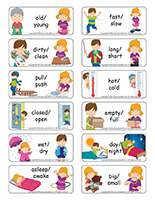
I can do the opposite
Select a child who will be the leader of the game and have him perform an action. The others watch him and perform the opposite action: run/walk, raise your hand/lower your hand, turn to the left/turn to the right.
Counting backwards
(Open game-I am learning numbers) Print and use the document to count with your group. Have fun counting backwards.
Let’s hop on the opposites
(Open word flashcards-Opposites) Print, laminate, and use adhesive paper to secure the flashcards on your daycare floor. Play music. When the music stops, children must quickly hop on a flashcard.
Fine motor skills-Crumpled opposites
(Open models-Opposites) Print for each child. Have them tear tissue paper into tiny pieces. Next, have children fill the shapes with the crumpled pieces of paper. Display children’s artwork.
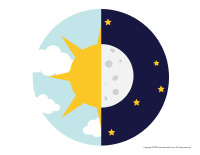
Modeling dough activity placemats-Opposites
(Open modeling dough activity placemats-Opposites) Print and laminate. Let children pick a placemat and provide modeling dough. Encourage them to use the dough to fill or reproduce the shapes that are on their placemat.
Roll & color-Opposites
(Open roll and color-Opposites) Print for each child. This game can be enjoyed individually or as a group. Children take turns rolling a die, counting the dots, and coloring the corresponding part.
Opposites hunt
(Open miniature opposites) Print and laminate. Hide the tiny blocks throughout your daycare and invite children to search for them. The child who finds the most can hide them for the following round.
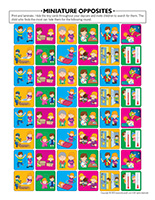
Hot/cold
Fill Ziploc bags with water, hair gel, or Jell-O. Set the bags in front the children in your group. Have some bags that are at room temperature and other bags that are frozen or, at the very least, refrigerated. Let children manipulate them.
Standing/sitting
Have children alternate between sitting and standing to help them assimilate the concept of opposites.
Light/dark
Have fun turning the lights on and off to provide children with the opportunity to explore another form of opposites.
COGNITIVE ACTIVITIES
Educ-pairs-Opposites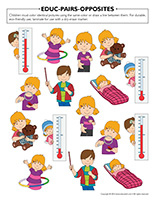
(Open educ-pairs-Opposites) Print. Children must color identical pictures using the same color or draw a line between them. For durable, eco-friendly use, laminate and use with a dry-erase marker.
Color by number-Opposites
(Open color by number-Opposites) Print for each child. Children must color the picture per the color code.
Opposites game
(Open game-Opposites) Print and laminate the game. You will need a die and a small figurine for each child. The figurines will be used as playing pieces. Children take turns rolling the die and moving their figurine a certain number of spaces, per what is indicated on the die. Next, they find the space illustrating the opposite of the space they landed on and move their figurine forward or backwards to set it on this space. Children will move ahead and back several times during this game.
Left/right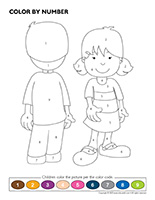
Unroll a long piece of white paper on the floor. Invite children to press both their hands in poster paint and then on your paper banner. Let dry. Using a washable marker, write “L” on each child’s left hand and “R” on each child’s right hand. Have them press their hand with an “L” on it on a left hand on the banner and their hand with an “R” on it on a right hand on the banner. Write “L” or “R” on several tiny Post-it notes and have them press them on the left and right hands. If children are very young, write the letters on 2 different colors of Post-it notes and use the same colors to write the letters on their hands. They can press their hand on the handprints to determine whether it is a left hand or a right hand.
Educ-trace-Opposites
(Open educ-trace-Opposites) Print for each child. Children must trace each line using a crayon of the corresponding color and then color the object at the end of the line using the same color.
Educ-same and different-Opposites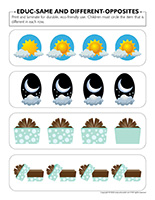
(Open educ-same and different-Opposites) Print and laminate for durable, eco-friendly use. Children must circle the illustration which is different in each row.
Hunt and seek-Opposites
(Open hunt and seek-Opposites) Print and laminate. Children pick a card and search for the item in the scene.
Educ-differences-Opposites
(Open educ-differences-Opposites) Print and laminate for durable, eco-friendly use. Children must find the differences between the two pictures and identify them using a dry-erase marker.
MORAL AND SOCIAL ACTIVITIES
Opposites day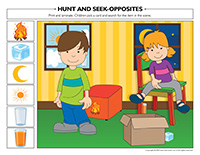
For an entire day, integrate as many opposites as possible. Invite children to wear their pyjamas to daycare. Put your clothing items on backwards and greet children by wishing them “good night”. Have children sit back-to-back during circle time. Walk backwards. Have children brush their teeth before eating. Serve dessert before the main course at lunch time. At story time, read the book from the last page to the first page.
Yes-No
Ask children questions. They must answer each question without saying “yes” or “no”.
EARLY SCIENCE/MANIPULATION/EXPLORATION
Rice bin-Opposites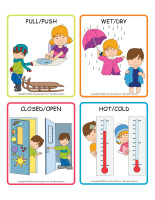
(Open picture game-Opposites) Print and laminate for durable, eco-friendly use. Hide the laminated pictures representing opposites in a rice or pasta bin. Children will enjoy digging them out and naming the opposites.
Happy people and sad people
(Open crafty game-Emotions book) Print and cut out the smiling character and the sad character. Glue each one on a small bin. Invite children to look at magazines and cut out pictures of happy and sad people. They can set them in the corresponding bin. Encourage them to name what leads them to believe that the people are happy or sad (tears, sparkle in the eyes, smile, laugh, mouth corners turned downwards, etc.).
Texture boxes
You will need an egg carton for each child as well as tiny items that have different textures: sandpaper, cotton balls, fake fur, velvet, corduroy, satin, feathers, sponges, textures paper, etc. Invite children to glue a small piece or item in each egg carton section. When they have glued a textured item in each section, have them close their eyes and touch the items one by one to determine which ones are soft and which ones are rough. They will love bringing their textured box home to explore with their family members.
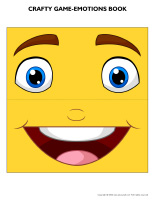
Hot/cold
Fill 2 bins with water. One must contain cold water and the other one must contain lukewarm water. Children can use the bins to explore contrasts. Let them play in the water with figurines or boats.
I float/I sink
Fill a large, clear bin with water. Gather several items. Children take turns setting an object in the water to see if it will float or sink.
Photo negatives
Find photo negatives and encourage children to observe them using flashlights. Ask them to name what they see and notice.
Heavy and light
Set a scale on a table and invite children to weigh 2 different items at a time so they can compare their weight and discover which ones are heavy and which ones are light.
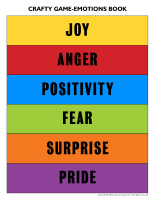
Opposites attract
Let children play with magnets. Show them how, if the magnets are identical, they will not stick together. In fact, they will repel each other. If 2 magnets are different, they will stick together. Using magnets, encourage children to identify other opposites (things magnets are attracted to and things magnets will not stick to).
Wet and dry
Add a small quantity of water to a bin and add cornstarch. When children pick up a handful of cornstarch, it will feel dry in their closed hand. However, when they open their hand, it will feel wet.
CULINARY ACTIVITIES
My quiet and noisy foods placemat
(Open my placemat-Opposites) Print a placemat for each child. Let them color the contour and the heading for each section. Invite them to cut out the food items. Provide the illustrated foods and invite children to taste them one by one. If a food item is noisy in their mouth, they must set it under the character that is speaking into a megaphone. If a food item does not make a sound in their mouth, they place it under the character that is whispering.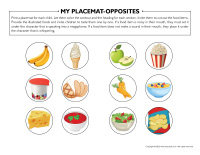
Opposites lunch
Have children bring lunch to daycare instead of you having to prepare it. Make sure they prepare something that can easily be heated and is inexpensive (ex. shepherd’s pie). If you prefer, simply ask children to bring a food from a particular family, a fruit for example. You can then prepare a fruit salad together.
ARTS & CRAFTS
Puppets-Opposites
(Open puppets-Opposites) Print the puppet models on heavy cardboard. Invite children to cut them out and decorate them with various materials. Attach a Popsicle stick to the back of each model to create a puppet.
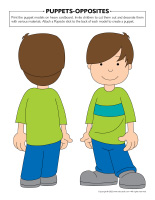
Darkness/light
(Open craft-light bulb) Print a light bulb on heavy paper for each child. Encourage them to apply glitter glue on their light bulb to represent incandescent filaments. Let dry. During this time, have children fold a piece of black construction paper in half and glue both sides to create an envelope. The top and bottom of the “envelope” must remain open. Once the glitter glue is dry, children glue a Popsicle stick behind their light bulb and slide it in their envelope. Show them how they can say “darkness” when their light bulb is completely hidden and then use the stick to slide their light bulb out of the top of their envelope and say “light” when it appears.
Clean hands, dirty hands
Invite children to trace each of their hands on 2 different types of paper. Write “DIRTY” on one hand and “CLEAN” on the other hand. Have children draw germs and dirt on their dirty hand. On their clean hand, they can use bingo markers to stamp circles that will represent soap bubbles. They can also cut a bar of soap or a liquid soap dispenser out of construction paper and glue it next to their clean hand. Use this project to discuss opposites and the importance of proper hand washing.
Growing dog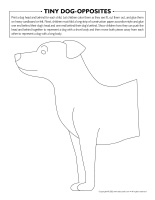
(Open tiny dog-Opposites) Print a dog head and behind for each child. Let children color them as they see fit, cut them out, and glue them on heavy cardboard or felt. Next, children must fold a long strip of construction paper accordion-style and glue one end behind their dog’s head and one end behind their dog’s behind. Show children how they can push the head and behind together to represent a dog with a short body and then move both pieces away from each other to represent a dog with a long body.
Mandalas-Opposites
(Open mandalas-Opposites) Print for each child. Invite children to color their mandalas to provide them with a relaxing activity whenever needed.
Opposites drawing
Have children use white chalk to draw on black construction paper.
Big and small hands
Hang a large white paper banner on a wall. Invite children to press their hands in poster paint and then on your banner. Ask parents to do the same and compare the sizes of the handprints.
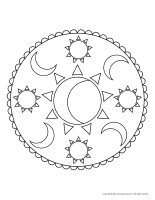
Over and under
Set a large piece of white paper on a table. Glue another piece of white paper under a table. Encourage children to draw a daytime scene on the paper that is over the table and a nighttime scene on the paper that is under the table.
Our opposites world
This activity can be done individually or as a group. Invite children to represent the opposite of their world. If, for example, they draw their family, their parents should be smaller than them, trees should be smaller than their house, etc.
Left hand/right hand
Begin by showing children they have a left hand and a right hand. Explain that they are to draw a picture first with one hand, and then the other. Use two different papers and write which hand was used to draw each picture. You may prefer to draw a line on a single paper dividing it into two sections and writing which hand was used to draw in each section.
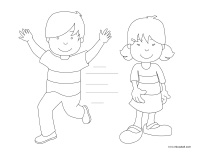
Backwards painting
Hang a large piece of paper on a wall. Have children paint with their back to the wall.
Painting with your feet
Since we are doing the opposite that we normally do during this theme, have children try to hold a paintbrush with their feet instead of their hands.
COLORING PAGES
(Open coloring pages theme-Opposites) Print for each child.
Have fun!
The educatall team
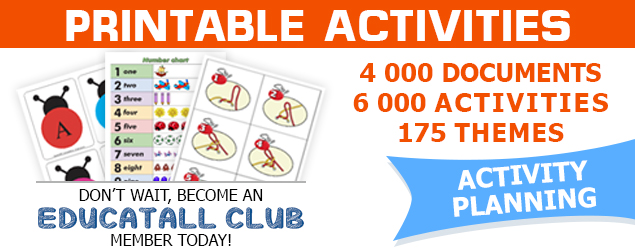
 Home
Home Theme activities
Theme activities
 Babies and toddlers
Babies and toddlers
 Arts and crafts
Arts and crafts
 Science
Science
 Creative recipes
Creative recipes
 Tips and tricks
Tips and tricks
 Special needs
Special needs
 Extra activities
Extra activities
 Educ-TV
Educ-TV
 Newsletter
Newsletter  Online store
Online store Educatall club
Educatall club


